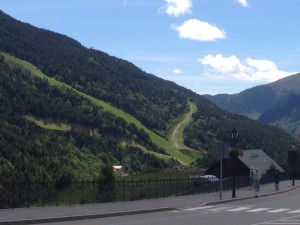Andorra is one of Europe’s several microstates. Others include Monaco, Liechtenstein, San Marino, Malta and the Vatican.
And if you get within a few hundred miles of a microstate, don’t you pretty much have to go? Just for the novelty of stepping into the country, and then stepping right back out?
So, we packed up the car with some snacks and some caffeinated drinks, in case the drive got boring … and off we went on another Sunday expedition.
And?
It was a slog.
Andorra’s economy pretty much is based on one industry — skiing.
Thus, our suspicion that the drive would include lots of narrow and winding mountain roads was confirmed. And it meant that a 190-mile drive, about what we did in three hours the week before, turned into a four-plus-hour slog.
To get there, from this part of France, you begin by riding the A9 motorway down to Perpignan, near the Spanish border, and we knocked that out in an hour.
Then it was off to the two-lane (one in each direction) highway, mostly west … for a long time. We stopped twice, once to pick up a shake at McDonald’s, once to have a look at some disappointing local produce (no, thanks), and much of the rest of the time we were climbing into the Pyrenees, the rugged, mile-high mountains that divide France and Spain.
It was one of those drives where you want to be behind the wheel, given that the driver is far less likely to get motion sickness than a passenger. Thus, I drove all the way, and the traffic was slight, thankfully.
It certainly is a scenic drive. Hills growing into mountains, streams widening into rivers … up and up and up. The discovery of a relatively flat space, which is sure to include a town and pasturage for sheep and cattle.
Aside from the highest peaks, everything is green, this time of year. It often would be white, from snow, for most of the year.
It is a nerve-racking drive, also. One of those “can I pass this guy on this curvy road?” things, as well as “should I speed up to get away from that tailgater?” Lots of calculating.
Some G force, through every curve, another set of gear-changing to get back up to some sort of speed. No straight roads for hours. Wearing.
But, finally, we were there, on the northeast side of the country, into one of its seven “parishes” — which seem a bit excessive, considering the country is only 181 square miles and has a population of 85,000.
Once you get into the Pyrenees it is clear why the Andorrans live there — to handle the ski crowd.
Andorra has a reputation for being something of a budget ski destination, cheaper than the Alps, for the French. (Though the Alps are easier to reach.)
The ski runs looked impressive, maybe even daunting, as we discovered them — the wide spots coming down a slope on which all the trees have been taken out. (As can be seen in the photo at the top of this entry.)
Once into the country, we saw all the signs of ski culture. Ski shops. Lots and lots of hotels/lodges, pretty much all of them built out of a brownish/tan rock — perhaps the mandated cladding for every building in the country.
As we took the main road down to the capital and “big” city, Andorra La Vella, we saw a tidy and what seemed to be prosperous country.
Andorra is notable as the only country where Catalan is the official language. Information signs are in four languages — Catalan, Spanish, French and English.
In theory, Andorra is governed by a Spanish bishop and the head of the French government. It was founded in the 10th century as a defensive anchor in the mountains, an impediment to the invading Moors.
Tourism accounts for about 80 percent of Andorra’s economy, and about 7 million of its annual 10.2 million visitors are in the country to ski.
The other significant chunks of the economy come from the country’s tax-haven status (making it the Caymans of southwest Europe) and its duty-free shopping.
When we reached the McDonald’s in the capital, which was directly across the street from the tourist-information building … we knew that we had reached the center of the country.
The capital and the rest of the county seemed pretty much empty, in mid-June, which was fine for the purposes of driving in and out.
We could have proceeded on through the country and exited it from the south, into Spain, and then back up to France … but that looked like more mountain driving than returning to where we entered.
So we retraced our path out of the country but this time branched off to the northwest at the interesting little town of Ax-les-Thermes, where cyclists appeared to be recovering from a competition.
Another long stretch in the car, but it was mostly straight driving, once we had exited the Pyrenees, and we were back before night had fallen, in a bit more than eight hours.
That is two European microstates for us this year — having done Monaco in January. Maybe we can make it three by getting down to Malta.


0 responses so far ↓
There are no comments yet...Kick things off by filling out the form below.
Leave a Comment